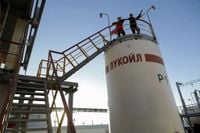In the early hours of November 6, 2025, the thunder of explosions and the glow of flames lit up the Volgograd skyline as a Ukrainian drone strike hit one of Russia’s largest oil refineries, forcing an immediate halt to operations. The Lukoil-operated Volgograd refinery, a sprawling industrial complex on the banks of the Volga River, found itself at the center of a rapidly escalating campaign by Ukraine to target the very heart of Russia’s energy industry.
According to multiple sources cited by Reuters, the attack damaged two of the refinery’s most critical processing units: the CDU-5 primary distillation unit and the hydrocracker. The CDU-5 alone, with a daily capacity of 66,700 barrels (or 9,100 metric tons), accounts for about one-fifth of the plant’s total output. The hydrocracker, with a capacity of 11,000 tons per day, is essential for producing high-value fuels. The resulting fire and structural damage forced the entire facility to suspend operations, a move that could ripple through both domestic and international fuel markets.
“The plant has been stopped. CDU-5 was on fire, there is some damage to the hydrocracker,” one source told Reuters on condition of anonymity. Lukoil, the Russian oil major that owns and operates the plant, did not respond to repeated requests for comment, leaving the industry and local residents in a state of uncertainty.
The strike was part of a coordinated operation by Ukrainian Special Operations Forces, according to Ukraine’s General Staff, who claimed responsibility for the attack in a statement on Telegram. Explosions and a subsequent fire engulfed the targeted area, and regional authorities confirmed the impact, although independent verification remains elusive. The local governor, Andrei Bocharov, reported that a 48-year-old man was killed by shrapnel, and several others were injured as drones struck both industrial and residential areas across the Volgograd region. The attack also disrupted air traffic and sparked multiple fuel-storage fires, compounding the chaos.
This is not the first time the Volgograd refinery has found itself in the crosshairs. In fact, Ukrainian forces have targeted the facility twice in just three months, reflecting Kyiv’s intensifying campaign since late 2023 to undermine Russia’s oil refining capacity. The Volgograd refinery processed 13.7 million metric tons of crude in 2024, accounting for about 5% of Russia’s total refining throughput, and is the largest producer of fuel and lubricants in Russia’s Southern Federal District. Its strategic location on the Volga River allows it to supply domestic markets and export refined products through Black Sea terminals, making any disruption here a significant blow to Russia’s energy logistics.
Ukrainian officials have been open about their objectives. As reported by Oilprice.com, Ukrainian strikes on Russian oil assets are seen as both a legitimate military target and an economic lever. By hitting refineries, depots, and pipelines, Kyiv hopes to deprive Moscow of the oil export revenue it needs to sustain its military campaign. SBU head Vasyl Malyuk recently stated that Ukrainian forces have attacked Russian oil production and refining facilities nearly 160 times since the beginning of 2025, with 20 such strikes recorded in September and October alone.
The timing of the Volgograd strike is particularly notable. It comes as new U.S. sanctions force Lukoil to divest global holdings, including assets in Europe and Africa. These sanctions have curtailed the company’s overseas operations and limited access to critical equipment and financial services, making it increasingly difficult for Lukoil to respond to domestic refinery disruptions. The lack of spare capacity and the ongoing threat of further attacks leave Russia’s energy sector in a precarious position.
The broader context is one of escalating tit-for-tat assaults on energy infrastructure by both sides. As The Associated Press and Los Angeles Times reported, Russia has responded to Ukraine’s drone campaign by targeting Ukraine’s power grid, aiming to deny civilians access to heat, light, and running water—a strategy that Kyiv officials have described as an attempt to “weaponize winter.” Ukrainian President Volodymyr Zelensky has acknowledged the relentless pressure on Ukraine’s energy sector, praising the daily efforts of power engineers and emergency crews as they work to restore services amid ongoing attacks.
The overnight drone barrage on November 6 was particularly intense. Russian officials reported that Ukraine launched at least 75 drones across several regions, triggering explosions and fires not only in Volgograd but also in the Kostroma region northeast of Moscow, where a major power plant was hit. The Russian Defense Ministry claimed its air defenses shot down 75 drones overnight, while Ukraine’s air force reported that Russia launched 135 drones of various types against Ukrainian targets the same night. The mutual targeting of critical infrastructure has become a grim hallmark of this phase of the nearly four-year-old war.
The impact of the Volgograd refinery outage is already being felt. Analysts warn that damage at the facility could reduce fuel supply to both domestic and international markets, potentially tightening product availability and lifting prices. Ukrainian officials have argued that their campaign has already reduced Russian refining output by as much as 17% in 2025, a figure that—if accurate—would have significant implications for global energy markets. Western refinery margins have reportedly benefited from the reduced Russian supply, though the long-term effects remain to be seen.
Meanwhile, the human cost of these operations is mounting. Local officials in Volgograd reported one fatality and several injuries from falling debris, while in Ukraine, Russian drone attacks killed one person and injured eight in the city of Kamianske. The relentless pace of attacks has also disrupted rail infrastructure in both countries, causing delays and forcing route changes.
Amid the destruction, both sides remain defiant. Ukraine’s General Staff has vowed to continue its campaign against Russian oil infrastructure, while Russian authorities insist they will repair and defend their critical assets. In the absence of meaningful diplomatic progress, the battle over energy has become a central front in the broader conflict, with each strike sending shockwaves far beyond the immediate blast zone.
With emergency crews still working to contain the damage and no restart timeline from Lukoil, the future of the Volgograd refinery—and the stability of the region’s energy supply—hangs in the balance. As winter approaches, the stakes for both sides could hardly be higher.


